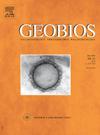Megaglomerospora lealiae nov. gen., nov. sp. from the upper Carboniferous of Portugal: the largest glomeromycotan fungal spores
IF 1.6
4区 地球科学
Q2 PALEONTOLOGY
引用次数: 0
Abstract
A new genus and species of fossil fungus, Megaglomerospora lealiae, is described from the Buçaco Carboniferous Basin (upper Stephanian C, Upper Pennsylvanian, upper Carboniferous), in central western Portugal. The new fossil fungus consists of a dense cluster of silicified large spores. These new fungal spores are oblong, subelliptical to subspherical-shaped, with a glabrous surface characterized by having a lipid-filled lumen, and display a strong septate-like hypha attached. The presence of lobe-shaped germination shields suggests close affinities to Diversisporales (Glomeromycota). Megaglomerospora lealiae nov. gen., nov. sp. is remarkably distinctive because it is by far the largest fossil fungal spore (∼1.6 mm long) documented for the phylum Glomeromycota. This is the first report of an endomycorrhizal‐like fungus from the Carboniferous of Iberia.
来自葡萄牙上石炭世的叶状巨聚孢:最大的肾小球真菌孢子
在葡萄牙中西部的buaco石炭世盆地(上斯蒂芬纪C,上宾夕法尼亚纪,上石炭世)描述了一种新的真菌化石Megaglomerospora lealiae属。新的真菌化石由密集的硅化大孢子簇组成。这些新的真菌孢子呈椭圆形,近椭圆形至近球形,表面无毛,具有充满脂质的腔,并显示有很强的分离样菌丝附着。叶状萌发屏障的存在表明其与Diversisporales (Glomeromycota)有密切的亲缘关系。叶状巨聚孢菌(Megaglomerospora lealiae, 11 . gen., 11 . sp.)非常独特,因为它是迄今为止记录在案的肾小球菌门中最大的真菌孢子化石(约1.6毫米长)。这是来自伊比利亚石炭纪的一种类似内生菌根的真菌的首次报道。
本文章由计算机程序翻译,如有差异,请以英文原文为准。
求助全文
约1分钟内获得全文
求助全文
来源期刊

Geobios
地学-古生物学
CiteScore
3.30
自引率
6.20%
发文量
28
审稿时长
6-12 weeks
期刊介绍:
Geobios publishes bimonthly in English original peer-reviewed articles of international interest in any area of paleontology, paleobiology, paleoecology, paleobiogeography, (bio)stratigraphy and biogeochemistry. All taxonomic groups are treated, including microfossils, invertebrates, plants, vertebrates and ichnofossils.
Geobios welcomes descriptive papers based on original material (e.g. large Systematic Paleontology works), as well as more analytically and/or methodologically oriented papers, provided they offer strong and significant biochronological/biostratigraphical, paleobiogeographical, paleobiological and/or phylogenetic new insights and perspectices. A high priority level is given to synchronic and/or diachronic studies based on multi- or inter-disciplinary approaches mixing various fields of Earth and Life Sciences. Works based on extant data are also considered, provided they offer significant insights into geological-time studies.
 求助内容:
求助内容: 应助结果提醒方式:
应助结果提醒方式:


